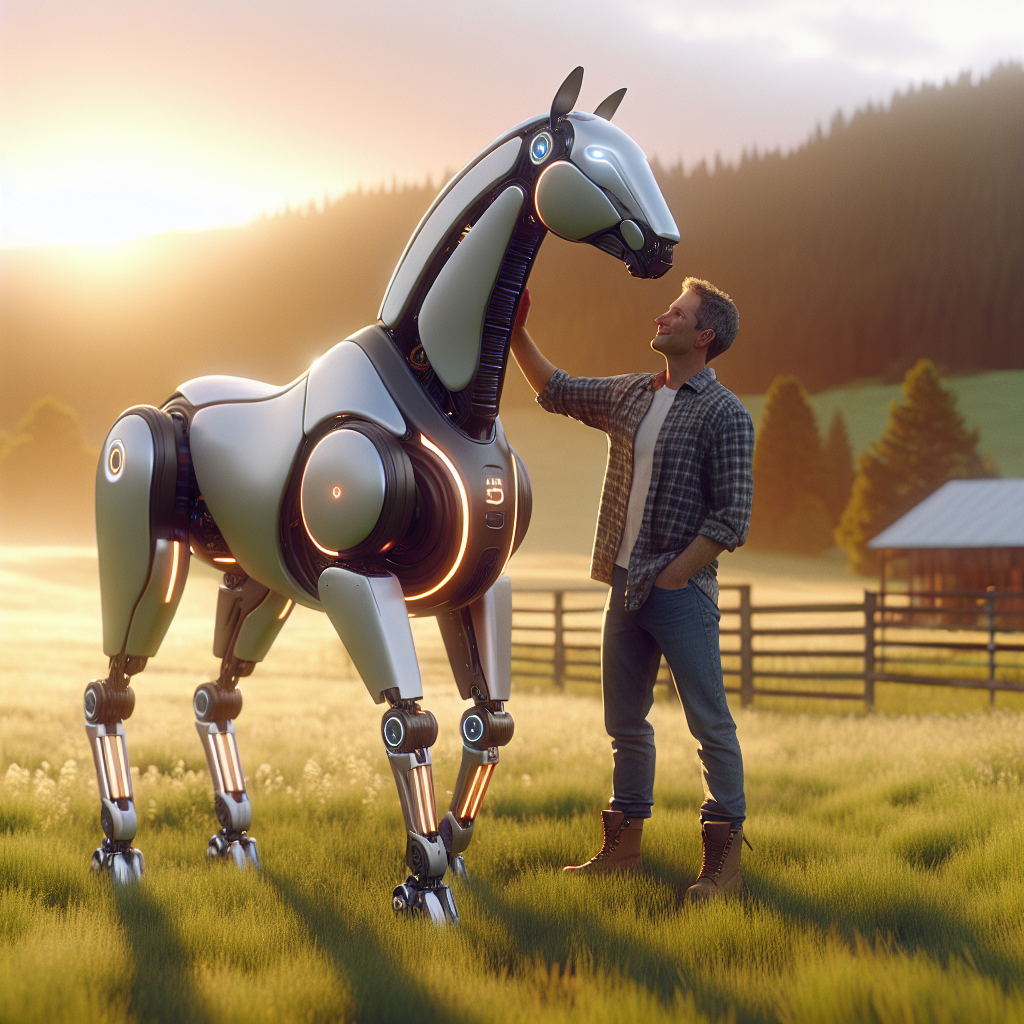
Kawasaki Unveils Revolutionary Hydrogen-Powered Robot Horse for Eco-Friendly Riding
In a move that has surprised and delighted tech enthusiasts and equestrians alike, Kawasaki has finally answered the call that apparently everyone has been making. The Japanese manufacturing giant revealed its groundbreaking hydrogen-powered robot horse at the Tokyo Mobility Show. This innovation marks a significant leap forward in eco-friendly transportation alternatives and fulfills a demand that, according to Kawasaki, has been overwhelming.
The Birth of Bex: Kawasaki’s Mechanical Steed
Dubbed “Bex,” this robotic quadruped represents the convergence of traditional horsemanship and cutting-edge technology. The machine draws inspiration from the endangered Ibex mountain goat, though its design clearly evokes equine characteristics. Kawasaki engineers have spent years perfecting this unique mode of transportation, which runs entirely on hydrogen fuel cells.
Standing approximately four feet tall at the shoulder, Bex can support riders weighing up to 220 pounds. The robot horse features an ergonomic saddle, stirrups, and reins that provide riders with a familiar control interface. However, unlike traditional horses, Bex never needs rest, doesn’t require feeding, and produces zero emissions beyond water vapor.
Technical Specifications and Capabilities
Bex isn’t just a novelty item – it’s a serious piece of engineering. The hydrogen fuel cell powering this mechanical steed delivers impressive performance metrics:
- Range of approximately 100 kilometers on a single hydrogen tank
- Top speed of 28 km/h (about 17 mph)
- Quick-refill capability (under 5 minutes for a full hydrogen tank)
- Advanced obstacle detection and terrain adaptation
- Weather-resistant exterior designed for various environments
The robot horse can traverse rocky terrain, climb moderate inclines, and navigate through areas inaccessible to conventional vehicles. Furthermore, Bex includes a cargo configuration option, where the saddle can be replaced with a flat storage platform capable of carrying up to 100 kg of goods.
Meeting “Overwhelming” Consumer Demand
According to Kawasaki’s press materials, the development of Bex was spurred by “overwhelming consumer interest” in hydrogen-powered robotic equines. Masashi Nagano, chief engineer on the project, explained the reasoning behind the unique vehicle.
“For years, our customer feedback surveys have shown one consistent request: a robot horse powered by hydrogen,” Nagano stated with complete seriousness. “We’re proud to be the first major manufacturer to address this clearly massive market demand.”
When pressed for actual data supporting this claim, Kawasaki representatives acknowledged that formal market research on robot horse demand was “ongoing” but insisted the need was “obviously there.”
The Curious Marketing Campaign
Kawasaki’s marketing strategy for Bex has raised eyebrows across the industry. Their promotional materials feature slogans such as “The Horse You’ve Been Waiting For” and “Finally, The Answer To Your Transportation Prayers.” One television advertisement even begins with the line, “You asked, and we listened!”
Social media response has been a mix of confusion and amusement. “Did I miss the memo where everyone decided they wanted robot horses?” tweeted one user. Another commented, “I didn’t know I needed a hydrogen horse until today, but now I can’t imagine life without one.”
Despite the questionable market research, Kawasaki remains confident in Bex’s appeal. The company has already announced plans for “Bex experience centers” in major cities where potential customers can test ride the mechanical steed.
Environmental Benefits and Practical Applications
Beyond the unusual premise, Bex does offer genuine environmental advantages. Traditional horses require significant resources including feed, water, and land. Meanwhile, conventional vehicles produce harmful emissions. The hydrogen-powered robot horse presents a potentially sustainable middle ground for certain applications.
Environmental scientists have cautiously praised the concept. Dr. Elena Matsura from the Sustainable Transport Institute notes, “While the market for robot horses might be questionable, the technology itself represents positive innovation in hydrogen fuel cell applications.”
Kawasaki has identified several practical use cases for Bex:
- Rural transportation in areas with poor roads
- Agricultural monitoring and light farming work
- Search and rescue operations in difficult terrain
- Eco-tourism in environmentally sensitive areas
- Film and entertainment productions
The Japanese Self-Defense Force has also reportedly expressed interest in military applications, though Kawasaki declined to comment on potential defense contracts.
Safety Features and User Experience
Safety has been a primary focus in Bex’s development. The robot horse includes a comprehensive suite of features designed to protect riders:
- Automatic stability control to prevent tipping
- Emergency stop function triggered by voice command
- Soft-fall technology that detects rider dismounts
- Adjustable speed limiters for novice riders
- Built-in connectivity for emergency services
The user experience is designed to mimic traditional horsemanship while incorporating modern conveniences. Riders control direction through the reins, but can also use voice commands for certain functions. A smartphone app allows owners to monitor Bex’s mechanical health, track usage statistics, and locate their robot horse remotely.
Industry Response and Market Potential
The announcement has generated mixed reactions from industry analysts. Transport specialist Kenji Yamamoto from the Tokyo Institute of Technology commented, “While the technology is impressive, Kawasaki seems to be creating a solution for a problem that doesn’t exist.”
Others see potential in specific niches. “There are actually legitimate use cases for robotic quadrupeds,” explains robotics expert Dr. Sarah Chen from Robotics Trends Magazine. “Whether they need to look like horses is another question entirely.”
Market projections for Bex remain speculative. Kawasaki has set an initial production target of 200 units for the first year, with a retail price of approximately $80,000 per unit. This positions Bex as a luxury item rather than mass-market transportation.
Competition and Future Developments
While Kawasaki claims to be first to market with a hydrogen-powered robot horse, other manufacturers are exploring similar concepts. Boston Dynamics has long showcased quadrupedal robots, though none designed specifically for human riding. Chinese startup RoboTerra announced plans for an electric riding robot last year, though their prototype has yet to materialize.
Kawasaki has already outlined its development roadmap for future Bex models. Planned improvements include:
- Increased range and speed capabilities
- Enhanced AI for more autonomous operation
- Smaller, more affordable consumer models
- Specialized versions for agriculture and emergency services
- Accessory options including weatherproof riding gear
The company has also hinted at plans for robot variants based on other animals, though they declined to provide specific details.
Public Reaction: Confusion, Humor, and Unexpected Interest
Public response to Bex has been characterized by initial confusion followed by curiosity. Social media analysis shows the announcement generated over 500,000 mentions in the first 48 hours, with sentiment skewing toward amused interest rather than practical intent to purchase.
However, Kawasaki reports that pre-order inquiries have exceeded expectations. Early adopters appear to come primarily from three demographics: wealthy tech enthusiasts, equestrian centers looking for novelty attractions, and eccentric entrepreneurs.
One pre-order customer, Silicon Valley venture capitalist Thomas Reynolds, explained his interest: “Is it practical? Absolutely not. Is it the coolest thing I’ve ever seen? Without question. I’ve already ordered three.”
Conclusion: A Bold Step or Marketing Gimmick?
Whether Kawasaki’s hydrogen-powered robot horse represents the future of transportation or an elaborate marketing exercise remains to be seen. What’s clear is that Bex has succeeded in capturing public attention and sparking conversation about alternative transportation methods.
The technology underpinning Bex – particularly its hydrogen fuel cell system and advanced locomotion capabilities – may prove valuable regardless of the product’s commercial success. These innovations could eventually find their way into more conventional applications.
For now, Kawasaki continues to insist that they’re simply giving customers what they’ve been demanding all along. And perhaps they’re right – after all, who hasn’t occasionally wished for a mechanical horse that never needs feeding, never gets tired, and runs on the most abundant element in the universe?
Bex is scheduled to begin limited production in early 2023, with demonstration models available at select Kawasaki dealerships later this year. Interested customers can join the waiting list through Kawasaki’s website, where they can also customize their robot horse’s exterior color and accessories.
What’s Your Take?
Would you consider riding a hydrogen-powered robot horse? Do you see practical applications for this technology, or is it simply a novelty item? Share your thoughts in the comments below, and let us know if a robot horse would find a place in your stable or garage!
References
- Kawasaki Robotics Division – Official information about Kawasaki’s robotics projects
- Hydrogen Council – Research on hydrogen fuel cell applications
- Robotics Trends Magazine – Analysis of emerging robotics technologies
- Sustainable Transport Institute – Research on eco-friendly transportation alternatives
- The Autopian – Original report on Kawasaki’s robot horse announcement


